Etude de bruit de fond induit par les muons dans l'expérience ...
Etude de bruit de fond induit par les muons dans l'expérience ...
Etude de bruit de fond induit par les muons dans l'expérience ...
You also want an ePaper? Increase the reach of your titles
YUMPU automatically turns print PDFs into web optimized ePapers that Google loves.
tel-00724955, version 1 - 23 Aug 2012<br />
1<br />
22 The Dark Matter problem<br />
halo fraction f < 0.2 (95% CL) for objects in the mass range between 2 · 10 −7 M⊙<br />
and 1 M⊙, dismissing earlier claims of a significant halo fraction of compact objects<br />
by the MACHO collaboration [45]. Compact objects within this mass range cannot<br />
account for more than 25% of a standard halo.<br />
Another example of candidates for Dark Matter are the light neutrinos. They<br />
are hot dark matter (HDM), rather than cold, and then would have substantial effects<br />
on the formation of large-scale structure. The investigation of the still open<br />
role of neutrino HDM in the evolution of large scale structure is one of the main<br />
motivations for the proposed next-generation tritium β <strong>de</strong>cay experiment KATRIN<br />
[46], which is <strong>de</strong>signed to measure the absolute mass of the electron neutrino with<br />
sub-eV sensitivity (a discovery potential down to about 0.35 eV/c 2 ). Correspondingly,<br />
KATRIN would be sensitive to a neutrino HDM contribution down to a value<br />
of Ων = 0.025, thus significantly constraining the role of neutrino HDM in structure<br />
formation. With its sensitivity, KATRIN will either <strong>de</strong>tect a neutrino mass<br />
of cosmological relevance or exclu<strong>de</strong> (in case of a negative result) any significant<br />
contribution of neutrinos to the universe’s matter content and structures.<br />
There is also the possibility that the dark matter problem could be explained<br />
by non-Newtonian gravity mo<strong>de</strong>ls, in which the strength of the gravitational force<br />
<strong>de</strong>creases <strong>les</strong>s rapidly than r −2 at large distance. However, gravitational lensing<br />
by the colliding galaxy clusters 1E0657-56 is a convincing dynamic system giving<br />
theory-in<strong>de</strong>pen<strong>de</strong>nt proof of dark matter dominance at large sca<strong>les</strong> [47]. It is ma<strong>de</strong><br />
up of two subclusters in the process of merging, which appear to have passed directly<br />
through one another, shown in Figure 1.15. The space between galaxies is<br />
large enough so that the galaxies in each subcluster have passed through the other<br />
subcluster without collisions. The intracluster medium (ICM), on the other hand,<br />
has been shocked and heated by the interaction, and remains concentrated closer to<br />
the collision point. This sets the stage for a very beautiful test of the dark matter<br />
mo<strong>de</strong>l: If the mass of the clusters is dominated by collision<strong>les</strong>s dark matter, then<br />
weak lensing will show two centers near the concentrations of galaxies. If, on the<br />
other hand, the mass is mainly in the ICM, with the high mass-to-light ratio of<br />
galaxies and clusters explained by modified gravity, then weak lensing should show<br />
one center, near the gas. When this system is studied and mapped with weak lensing,<br />
it shows that the lensing mass is concentrated in the two regions containing<br />
the galaxies, rather than in the two clouds of stripped gas which contain most of<br />
the baryonic mass and significantly se<strong>par</strong>ated from the highest intensity of X-rays<br />
[47, 48]. Weakly interacting dark matter would move together with the galaxies, and<br />
therefore explains the observed system. The bullet cluster of 1E0657-56 is not a sole<br />
example, more cases have been studied since, see [49, 50, 51]. And all agree to a nonbaryonic<br />
cold dark matter. These observations present a difficulty for alternative<br />
gravity theories.<br />
Nonethe<strong>les</strong>s, there is a strong consensus in the astrophysics community that<br />
non-baryonic cold dark matter best explains the wealth of cosmological observations<br />
available to us, and is a real component of the universe in which we live. The leading<br />
nonbaryonic cold-dark-matter candidates are axions and weakly interacting massive<br />
<strong>par</strong>tic<strong>les</strong> (WIMPs). The following sections <strong>de</strong>scribe the properties of these two main<br />
<strong>par</strong>ticle candidates for cold dark matter.




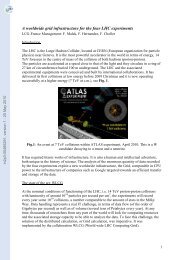

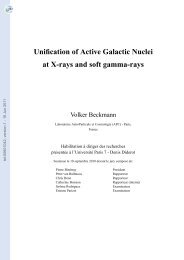

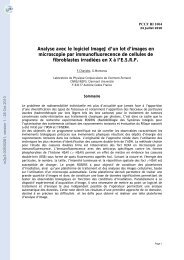
![[in2p3-00383985, v1] NUCLEAR PHYSICS at GANIL ... - HAL - IN2P3](https://img.yumpu.com/19016755/1/185x260/in2p3-00383985-v1-nuclear-physics-at-ganil-hal-in2p3.jpg?quality=85)
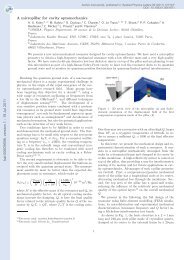
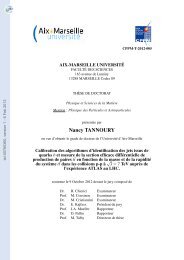
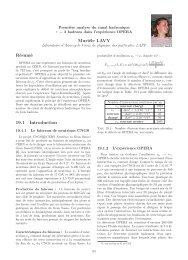
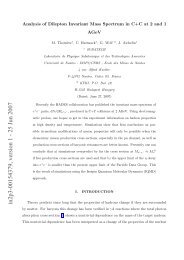
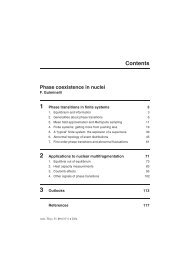
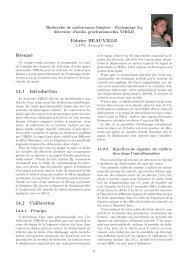
![[tel-00752304, v1] Pions réels et virtuels dans les noyaux](https://img.yumpu.com/19016523/1/184x260/tel-00752304-v1-pions-reels-et-virtuels-dans-les-noyaux.jpg?quality=85)